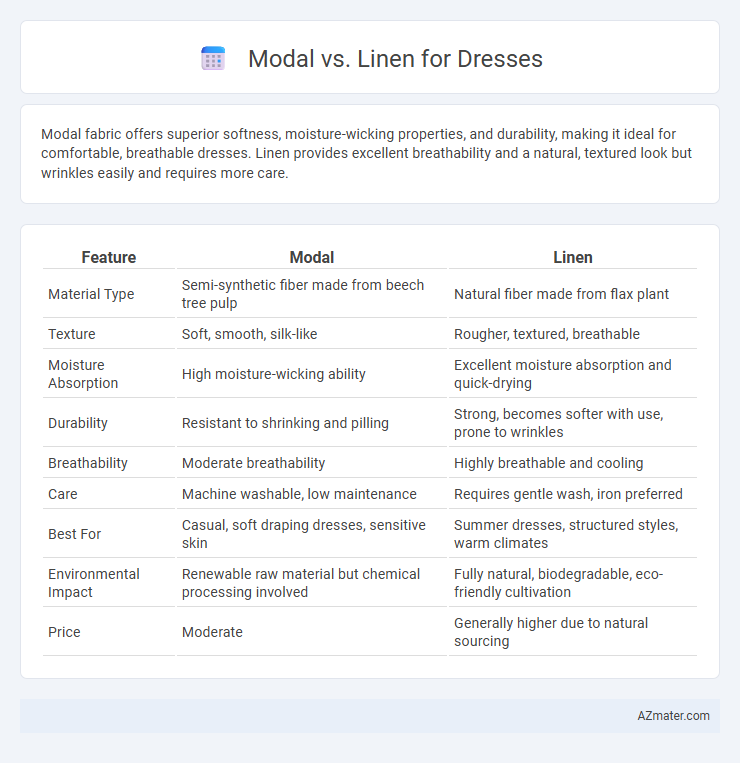Modal fabric offers superior softness, moisture-wicking properties, and durability, making it ideal for comfortable, breathable dresses. Linen provides excellent breathability and a natural, textured look but wrinkles easily and requires more care.
Table of Comparison
| Feature | Modal | Linen |
|---|---|---|
| Material Type | Semi-synthetic fiber made from beech tree pulp | Natural fiber made from flax plant |
| Texture | Soft, smooth, silk-like | Rougher, textured, breathable |
| Moisture Absorption | High moisture-wicking ability | Excellent moisture absorption and quick-drying |
| Durability | Resistant to shrinking and pilling | Strong, becomes softer with use, prone to wrinkles |
| Breathability | Moderate breathability | Highly breathable and cooling |
| Care | Machine washable, low maintenance | Requires gentle wash, iron preferred |
| Best For | Casual, soft draping dresses, sensitive skin | Summer dresses, structured styles, warm climates |
| Environmental Impact | Renewable raw material but chemical processing involved | Fully natural, biodegradable, eco-friendly cultivation |
| Price | Moderate | Generally higher due to natural sourcing |
Overview: Modal vs Linen for Dresses
Modal fabric offers a smooth, soft texture with excellent moisture-wicking properties, making it ideal for comfortable, breathable dresses suitable for warm weather. Linen, on the other hand, is a natural fiber known for its durability, lightweight feel, and distinct texture, providing a crisp, breathable option that ages beautifully with wear. Both fabrics excel in breathability and comfort, but Modal delivers superior stretch and softness, while Linen offers a classic, eco-friendly appeal and enhanced durability.
Material Composition: What Are Modal and Linen?
Modal is a semi-synthetic fiber made from beech tree pulp, known for its softness, breathability, and moisture-wicking properties, making it ideal for lightweight dresses. Linen is a natural fiber derived from the flax plant, valued for its durability, breathability, and distinctive textured appearance that enhances dress aesthetics. Both materials offer breathable comfort, but modal provides a smoother feel, while linen delivers a crisp, natural texture.
Comfort and Breathability Compared
Modal fabric offers superior softness and moisture-wicking properties, making it exceptionally comfortable for dresswear. Linen excels in breathability and durability, allowing for excellent airflow and cooling in warmer climates. While modal feels smooth and stretchy against the skin, linen provides a crisp texture that becomes softer with each wash, enhancing overall comfort.
Softness and Texture: Feel on the Skin
Modal fabric offers exceptional softness and a silky texture, making it feel smooth and cool against the skin. Linen, while breathable and lightweight, has a natural coarser texture that softens with wear but initially feels more textured and slightly rougher compared to modal. For a dress, modal provides a more luxurious and gentle touch ideal for sensitive skin, whereas linen delivers an organic, breathable feel with a distinct tactile character.
Durability and Longevity of Each Fabric
Modal fabric offers enhanced durability due to its high wet strength and resistance to shrinkage, ensuring longer-lasting dresses even after repeated washing. Linen, while naturally strong and breathable, tends to weaken and develop wear spots over time, especially with frequent laundering. Therefore, modal provides superior longevity for dress fabrics compared to linen, making it a more resilient choice for durable apparel.
Style and Drape: How Dresses Fall
Modal fabric offers a smooth, fluid drape that enhances the silhouette with a soft, elegant fall ideal for form-fitting dresses. Linen features a more structured and textured drape, creating a crisp, airy look that adds natural volume and casual sophistication to garments. The difference in drape influences the overall style, with modal catering to sleek, polished dresses and linen suiting relaxed, breathable designs.
Care and Maintenance Requirements
Modal fabric requires gentle care, typically hand washing or machine washing on a delicate cycle with cold water to maintain its softness and prevent shrinking. Linen, known for its breathability and durability, can be machine washed but often benefits from air drying and ironing to avoid wrinkles and preserve its natural texture. Modal is less prone to wrinkles than linen, making it lower maintenance, while linen needs more frequent care to keep its crisp appearance.
Sustainability and Eco-Friendliness
Modal fabric, derived from sustainably sourced beech trees, offers a biodegradable and eco-friendly alternative to conventional textiles with lower water consumption and reduced chemical use during production. Linen, made from flax plants, boasts high biodegradability and requires minimal pesticides, thriving in poor soil conditions that decrease environmental impact and promote sustainable agriculture. Both fabrics support sustainable fashion by providing durable, breathable garments with a significantly smaller carbon footprint compared to synthetic fibers.
Cost Comparison: Modal vs Linen Dresses
Modal dresses generally cost more than linen dresses due to the more complex manufacturing process and the use of beech tree pulp in modal fabric production. Linen dresses tend to be more affordable and widely available, benefiting from the natural flax fibers and simpler weaving methods. While modal offers a softer texture and better drape, linen is prized for its durability and breathability at a lower price point.
Choosing the Right Fabric for Your Next Dress
Modal fabric offers exceptional softness, breathability, and moisture-wicking properties, making it ideal for comfortable, everyday dresses that require a smooth drape. Linen, valued for its natural texture and durability, is perfect for lightweight, breathable summer dresses but tends to wrinkle easily, impacting its crisp appearance. Choosing the right fabric depends on your desired dress style, occasion, and maintenance preferences, with modal excelling in softness and ease of care, while linen provides a classic, breathable feel with a more textured look.

Infographic: Modal vs Linen for Dress
 azmater.com
azmater.com